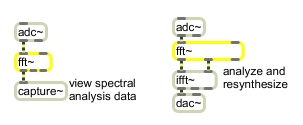Examples

Fast Fourier transform of an audio signal
Fast Fourier transform
| Name | Type | Opt | Description |
|---|---|---|---|
| number-of-FFT-samples | int | opt | The first argument specifies the number of points (samples) in the FFT. It must be a power of two. The default number of points is 512. The second argument specifies the number of samples between successive FFTs. This must be at least the number of points, and must also be a power of two. The default interval is 512. The third argument specifies the offset into the interval where the FFT will start. This must either be 0 or a multiple of the signal vector size. fft~ will correct bad arguments, but if you change the signal vector size after creating an fft~ and the offset is no longer a multiple of the vector size, the fft~ will not operate when signal processing is turned on. |
| signal | In left inlet: The real part of a complex signal that will be transformed. In right inlet: The imaginary part of a complex signal that will be transformed. If signals are connected only to the left inlet and left outlet, a real FFT (fast Fourier transform) will be performed. Otherwise, a complex FFT will be performed. |

| Name | Description |
|---|---|
| cartopol | Cartesian to Polar coordinate conversion |
| cartopol~ | Signal Cartesian to Polar coordinate conversion |
| fftin~ | Input for a patcher loaded by pfft~ |
| fftinfo~ | Report information about a patcher loaded by pfft~ |
| fftout~ | Output for a patcher loaded by pfft~ |
| frameaccum~ | Compute "running phase" of successive phase deviation frames |
| framedelta~ | Compute phase deviation between successive FFT frames |
| ifft~ | Inverse fast Fourier transform |
| index~ | Sample playback without interpolation |
| pfft~ | Spectral processing manager for patchers |
| poltocar | Polar to Cartesian coordinate conversion |
| poltocar~ | Signal Polar to Cartesian coordinate conversion |
| vectral~ | Vector-based envelope follower |
| MSP Tutorial 25: Using the FFT | MSP Tutorial 25: Using the FFT |